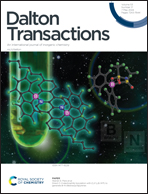Theoretical insights into selective extraction of Am(iii) from Cm(iii) and Eu(iii) with asymmetric N-heterocyclic ligands†
Abstract
Separation of lanthanide (Ln) and minor actinide (MA) elements and mutual separation between minor actinide elements (e.g. Am(III) and Cm(III)) represent a crucial undertaking. However, separating these elements poses a significant challenge owing to their highly similar physicochemical properties. Asymmetric N-heterocyclic ligands such as N-ethyl-6-(1H-pyrazol-3-yl)-N-(p-tolyl)picolinamide (Et-p-Tol-A-PzPy) and N-ethyl-N-(p-tolyl)-1,10-phenanthroline-2-carboxamide (ETPhenAm) have recently received considerable attention in the separation of MAs over Ln from acid solutions. By changing the central skeleton structures of these ligands and introducing substituents with different properties on the side chains, their complexation behavior with Am(III), Cm(III), and Eu(III) may be affected. In this work, we explore four different asymmetric N-containing heterocyclic ligands, namely Et-p-Tol-A-PzPy (L1), N-ethyl-6′-(1H-pyrazol-3-yl)-N-(p-tolyl)-[2,2′-bipyridine]-6-carboxamide (L2), N-ethyl-9-(1H-pyrazol-3-yl)-N-(p-tolyl)-1,10-phenanthroline-2-carboxamide (L3), and ETPhenAm (L4) using density functional theory (DFT). The calculated results demonstrate the potential of ligands L1–L4 for the extraction and separation of Am(III), Cm(III), and Eu(III). Ligand analysis shows that ligand L3 binds more easily to the central metal atom, in line with the stronger extraction capacity of L3. In spite of the higher covalence between the side chain and the central metal atom for complexes with L1–L3, the main chain seems to control the stability of the extraction complexes. The preorganized 1,10-phenanthroline backbone also further enhances the extraction performance of L3 and L4. The difference in coordination ability between the side chain donors of these ligands and metal ions may affect their separation efficiency. This work presents theoretical insights into synthesizing novel ligands for separating trivalent actinides by adjusting N-heterocyclic ligands.



 Please wait while we load your content...
Please wait while we load your content...